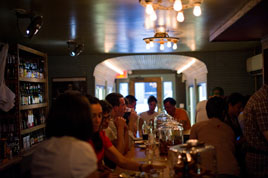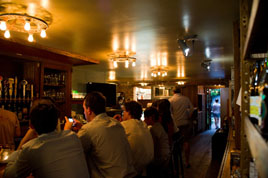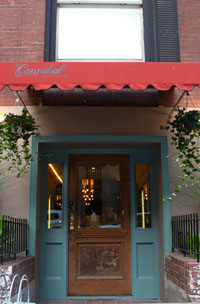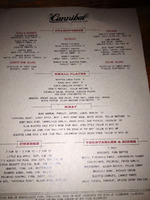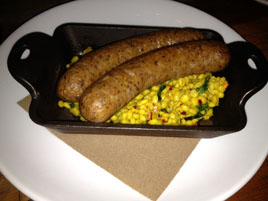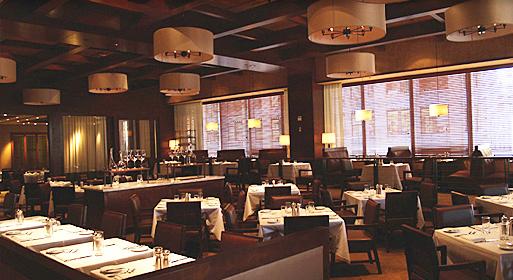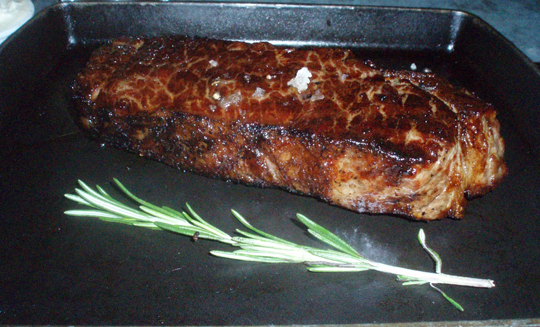

 I never realized how desperate the Upper East Side was for a great steakhouse. Laurent Tourondel did. He opened Arlington Club on Lexington Avenue four months ago and scored a bullseye: an instant hit.
I never realized how desperate the Upper East Side was for a great steakhouse. Laurent Tourondel did. He opened Arlington Club on Lexington Avenue four months ago and scored a bullseye: an instant hit.
You’d figure Tourondel can nail a steakhouse. His BLT Steak (opened nine years ago, and since replicated in a dozen cities) practically defined the modern steakhouse movement: the appetizers and non-steak entrées are terrific, and you swoon over the side dishes as much as the steaks themselves.
Since the failure of Cello, an old-school three-star seafood restaurant, in 2002, Tourondel has been more obsessed with replicable populism than excellence. The man can cook, but who runs the show when he is absent? All of his post-Cello places have been bedeviled with inconsistency.
And none of them have had management that complemented Tourondel’s skill in the kitchen. His BLT partnership with the restaurateur Jimmy Haber ended in an acrimonious divorce in 2010. Now he’s in bed with the Tao Group, the geniuses behind a chain of terrible, but highly profitable, restaurants, such as Tao, Lavo, and Marble Lane. If Tourondel is half the perfectionist he is reputed to be, it’s hard to imagine how he’ll tolerate being beholden to these clowns.
For now, Arlington Club is BLT Lavo, neither as bad as the Tao group’s other outfits, nor as good as it could be if Tourondel ever found the right partner. Tourondel’s DNA is evident in the excellent steaks, the sides, and the heavenly popovers. Tao Group’s DNA is evident in the mediocre service, the clubby crowd, and the spectacular build-out—resembling, and as noisy as, a European train station.
I booked a 5:45 pm table on a Saturday evening. A host called to warn me that my party would not be seated if it were incomplete, and that the table would be forfeited after 15 minutes. That was after they already took a credit card number in advance. Never mind that, according to multiple critics, tables are frequently not available at the promised time. A restaurant that can’t keep to its own schedule has no business lecturing customers about punctuality.
At check-out, I was compelled to sign the bill twice, both before and after I presented my credit card. “It’s our policy,” said the server, who didn’t even try to explain it.
According to Bloomberg’s Ryan Sutton, bar tabs are not transferrable to the table—an inexcusable lapse at a restaurant where even modest eaters will struggle to keep the bill under $125 per person. The wine list offers a wide selection, from the low $50s up to four figures; but then, they’ll serve your super-Tuscan in the same glass as they’d serve a Pinot Grigio.
This is what you get when a respected chef goes into partnership with the Tao group: a restaurant practically designed to suck. But with Arlington Club perpetually packed these days, the money-vacuum at Corporate has no reason to change: they just keep hoovering up the dough.
 Having said that, the service staff themselves were extremely good. The server gave excellent ordering advice; plates were cleared promptly, and the staff must have circled back half-a-dozen times to wipe crumbs off the table.
Having said that, the service staff themselves were extremely good. The server gave excellent ordering advice; plates were cleared promptly, and the staff must have circled back half-a-dozen times to wipe crumbs off the table.
The food was fine, but not good enough to justify the Tourondel premium. The price of the menu’s centerpiece, the côte de boeuf, has been on a rocket’s trajectory: $110 in early January (when The Post’s Steve Cuozzo awarded three stars), $115 in mid-January (when The Times’s Pete Wells awarded two), $125 by the end of January (when Bloomberg’s Ryan Sutton awarded half-a-star), and $130 today. Most of the menu has seen a similar, if not quite as spectacular, an increase over the past few months.
At today’s prices, the menu offers a selection of sushi rolls ($12–21), raw fish and seafood ($14–28), appetizers ($14–26), steaks ($36–65 per person), composed mains, referred to as “specialties” ($26–59) and a wide assortment of sides ($11–15). The sushi, by the way, has been panned by all three of the pro critics that have reviewed it. We were not about to touch it with a barge pole.
The meal begins with the legendary popovers (above left), a feature wisely retained from the BLT franchies, served here (inexplicably) with pickles. The recipe has changed since we last visited BLT Prime, and I like these a bit less—they taste a bit too eggy—but they remain a highlight of dinner at any Tourondel restaurant.


Calamari Salad ($17; above left) and Fluke crudo ($14; above right) were competent but unremarkable.


That côte de boeuf (above; $130 for two), served with a trench of bone marrow, is very good and perfectly cooked to the medium rare we requested (not a guarantee here, given the comments of multiple pro reviewers). There’s an appealing crunchy char on the outside, although the meat doesn’t quite have as much dry-aged flavor as I’d like.


The steak comes with the French Fries (normally $10 if ordered separately). Full credit to the server for letting us know (the menu made no mention of them), and urging us to cancel a separate order of “Potatoes Arlington,” which would have been wasted on us. The fries are doused with an excess of cheddar powder and what the menu calls “spices,” which tasted to us like truffle oil. They were merely okay.
The Truffled Gnocchi ($15; above right) are superb, an expensive side dish well worth it.


There are about a dozen wonderful gelati and ice creams, all made in house. The server rattled them off from memory, all of them funky combinations like chocolate popcorn, of which we chose three ($8; above left). A couple of small pastries resembling beignets (above right) stood in for petits fours.
There’s much to like at Arlington Club. We weren’t served a bad dish, and several were very good. If I lived nearby, I’d go back. But the “steakhouse-plus” genre that Tourondel pioneered is no longer a novelty. For the same money, you can visit Porter House or Minetta Tavern, where the food is more consistent and the service is better.
Arlington Club (1034 Lexington Ave. between 73rd–74th Streets, Upper East Side)
Food: Steakhouse plus, BLT style
Service: Very good at the table with a terrible corporate owner
Ambiance: A gorgeous, stylized European train station (and as noisy)
Rating: ★
Why? The genre is no longer novel, and Tourondel fails to improve on it
 Monday, April 29, 2013 at 07:00PM
Monday, April 29, 2013 at 07:00PM 
 Parea was relevant for a short while, back in 2006, when Frank Bruni gave it two stars. When I visited for the first time, in early 2007, I thought he was exactly right, but a later visit found a restaurant that had run off the rails.
Parea was relevant for a short while, back in 2006, when Frank Bruni gave it two stars. When I visited for the first time, in early 2007, I thought he was exactly right, but a later visit found a restaurant that had run off the rails.













